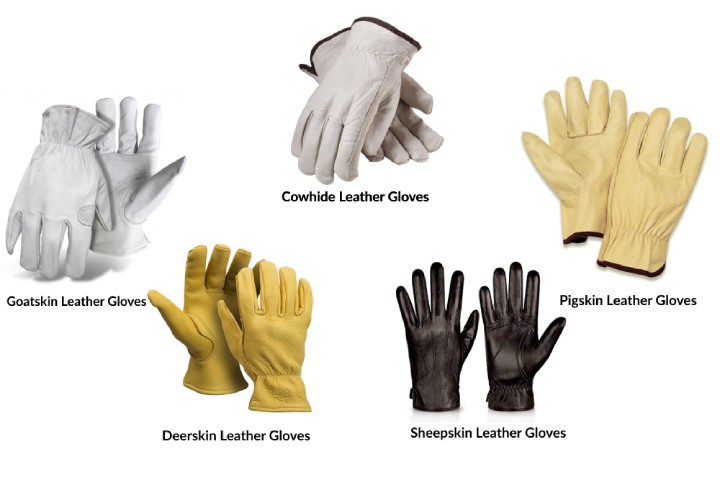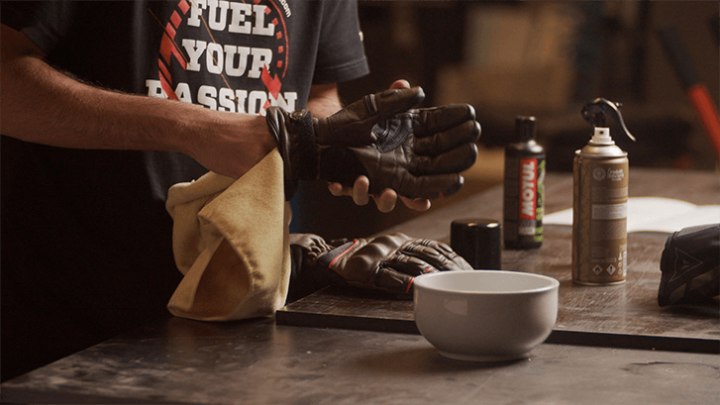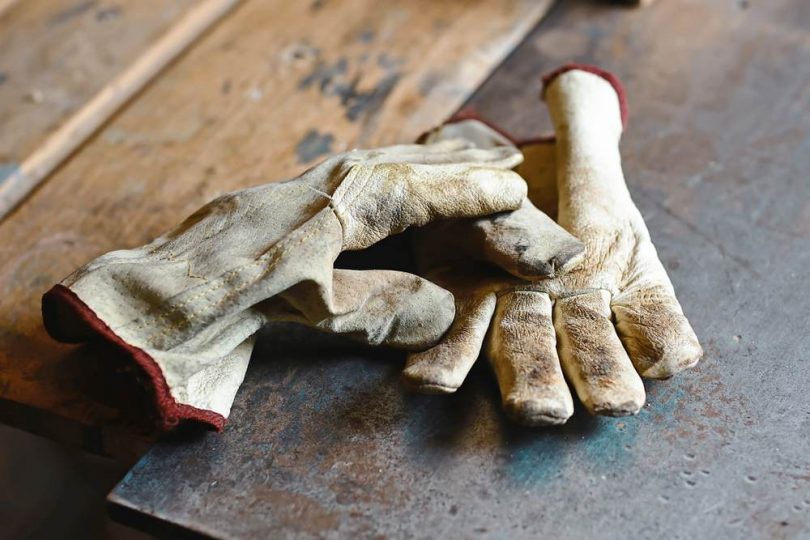Leather gloves need to be taken care of to keep the leather healthy and shiny. They can get dirty easily or grow fungus if not washed properly. So, you have to clean your pair after work to get the dirt, dust, or other stuff that gets stuck in the leather and the lining. Cleaning and maintaining your leather gloves often will help keep their longevity, flexibility, and dexterity in the long run.
Types of Leather Used for Hand Gloves

1. Cowhide leather
Cowhide leather gloves are generally the cheapest and easily available in the market. Gloves of this leather have to be somewhat thicker so that hands are protected. So they are hard and stiff, making them harder to break in. However, as they are cheap and have better heat resistance, they can be used for heavy-duty work.
2. Goatskin
Goatskin leather gloves are the default work glove that provides the most dexterity than any other gloves. Goatskin has an extremely tight grain structure and natural lanolin, making them abrasion and cut resistant. They are a great choice for heavy-duty work as these gloves are inexpensive, supple, and thinner than cowhide leather gloves.
3. Pigskin
Pigskin leather gloves are dense like cowhide leather and their abrasion resistance is as finest as goatskin. They are durable and somewhat supple, wet resistant, and breathable. These gloves lose their stiffness over time without losing their texture and shape.
4. Deerskin
Deerskin leather gloves are light-duty work gloves. They are strong yet soft, flexible, and easiest to break in. These are the only type of leather that dries down even softer after getting wet and does not crack. Deerskin leather gloves are mainly used for fashion staples for snowy winter.
5. Sheepskin
Sheepskin is also known as shearling or lamb leather, as the leather is from sheep hide or lamb. They are very soft and flexible among other types of leather.
Sheepskin leather gloves are winter gloves that keep hands safe from frostbite. It’s one of the warmest leather as one side is covered with wool and one side is leather keeps it ideal for cold weather.
Different Grades of Leather for Gloves
1. Full grain leather
Full-grain leathers are the highest quality leathers made of the outer layer of the hide. They have more imperfection as they are presented in more of a raw state. There are grains filled with fiber that makes the full-grain leather gloves more durable, and strong.
2. Split leather
Split Leathers typically are genuine leather, which is split from the thick animal hide into cross-section layers. They are sanded or buffed, dyed, and sprayed to get rid of any imperfection that is seen on the outer layer. These may reduce the quality of the product.
Common Causes of Damage to Leather Gloves

1. Leather gloves drying out
Leather gloves can naturally lose moisture and dry out. If the leather gloves get close to any external heat; such as fire, hairdryer, or radiator, they will likely dry out and get damaged.
2. Growth of mold
Mold, typically the aspergillus, like funguses grow on leather gloves at a certain temperature. If your gloves are not clean and kept in a damp atmosphere, there could be mold buildup. Some types of molds are hard to detect at first and to get rid of when they grow.
3. Chemical damage
Work gloves can get chemical damage as well as scratches. Then again cleaning products such as harsh soaps, detergents contain chemicals that damage leather gloves and result in damaged discolored leather.
Leaving your leather gloves exposed to direct sun can damage the fiber of your leather gloves.
Tips to Care for Leather Work Gloves
1. Taking care of drying out gloves
The best way to keep your leather gloves soft and in texture is to let them breathe. If the gloves get soaked in water air dry them. Do not use any external heat to quicken the drying process as it will do more harm than good.
If your gloves are already drying out, you should put a leather conditioner on them. Clean your leather gloves and then apply a leather conditioner to bring back the moisture. You can also rub animal oil (mink oil, neatsfoot oil) or vegetable oils (olive oil, coconut oil) on your leather gloves to prevent drying out.
2. Tackling the rot damage issue
You have to keep your gloves clean to prevent them from any mold or fungus. Use a damp cloth and clean the surface of your leather gloves to get rid of any dirt, or dust that can grow mold.
Then air dries the wet pair of gloves. Otherwise, soaked leather gloves will rot eventually with a bad odor.
To prevent from rotting, store your gloves in a dry place. Keep using them now and then, as frequently used leather gloves tend to hold out longer than those which are stockpiled somewhere for safe-keeping.
3. Tackling chemical damage
Accidental chemical damage may lead to brittle, discoloration, and burn spots on leather gloves. If your gloves get in contact with the chemical component, use olive oil to bring back the pigment of the leather.
There are leather dye products to get the color of your leather gloves.
The Complete Guide On Cleaning Leather Gloves

1. Get rid of the dirt
First, dampen a clean cloth or rag and take mild soap solution on it.
Create a lather with the cloth and rub the leather gloves thoroughly. Get into the corners and leather linings to remove the dirt and oil.
If your gloves have ornaments and design stitches, then gently rub them with the cloth to get rid of the grime.
Now take another piece of damp cloth to wipe the soap lather off.
Repeat the process if you miss any spots.
2. Hold the pair under running water
To clean off any spot, put the gloves on your hands and hold them under running water. Wait for 3 to 5 seconds and then put some mild soap on your leather gloves.
Rub the soap solution on the leather pairs with your hands which will create foam. Now hold the gloves under tap water to rinse off
3. Dry the gloves
Take a dry towel and dab with it to remove excess water from your gloves. Then lay the gloves flat to air dry at normal temperature.
You can wear them once in a while they are drying. Body heat will naturally dry your gloves from inside and fasten the drying process without doing any harm to your leather pair.
Cleaning your gloves should not be just using any soap or detergent to get rid of grime. You have to be mindful while choosing soap for your leather gloves because chemicals can be harmful to the skin of your gloves. Also, make sure that you dry them well before storage.
Working leather gloves should be cleaned once or twice a week. While washing them be cautious of the different colors on the leather or stitches. Leather gloves can perform heavy-duty work for years if they are given proper care. So wear them as often as possible and remember to wash them and moisturize once in a while.
FAQs
1. Should we use mink oil on leather gloves?
Ans. Mink oil darkens your leather gloves and brings back moisture to dull leather. It will also keep your gloves waterproof. If there are any scratches or marks that you want to remove, rub mink oil on the spot to remove them.
2. Can you wash leather gloves in the washing machine?
Ans. Yes, you can wash leather gloves in the washing machine except for some leather gloves that are not washable in the washing machine. You can use a mild soap solution to wash the pairs in the washing machine. But you cannot wash delicate leather gloves with thin lining in the washing machine as they might rip. Then again, be cautious of what type of detergent or soap you are using as it might cause chemical damage.
3. How to make the inside clean?
Ans. Take the same amount of vinegar and water in a spray bottle. Now turn the pair inside out and then spray with vinegar water. Let them air dry after spraying the inside leather.
This will keep your gloves’ inside clean and get rid of any bad odor.
4. How to make work gloves last longer?
Ans. Choose your work gloves according to your job role. Goatskin leather gloves will tolerate better work pressure than deerskin gloves. So the longevity depends on which type of leather you are investing in for your work leather gloves. Secondly, you should clean your work gloves so that molds do not grow on them and ruin the leather. Finally, do not dry them with external heat or put them out under the direct sun, which will make your gloves crack.










Leave a Comment